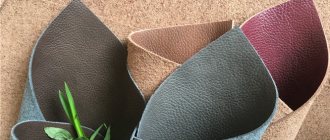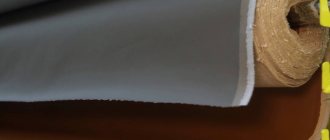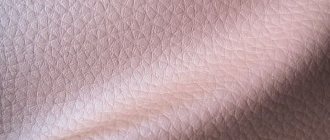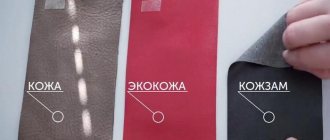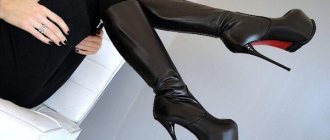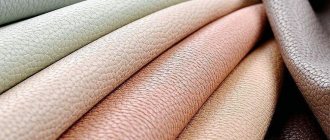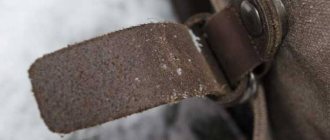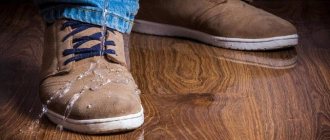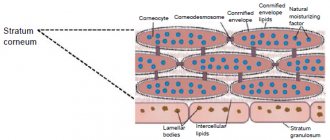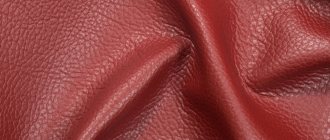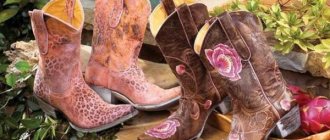Let's look at the names
You will almost never meet a salesperson who is educated as a leather production technologist. Therefore, each of them names the material as it turns out. The most often used “synonym” has nothing to do with reality. Thus, intentionally or accidentally, the buyer is misled. The article was written for the website Chistyulya.info. All other reprints are content theft!
Composite leather consists of natural elements. No matter what the seller calls this material, the essence does not change. We will return to production technology later. However, in order not to be deceived, you should know the correct names that reflect the essence.
Composite leather or eco-leather? See the list:
Correct : natural, pressed, composite, bonded, recycled.
Incorrect : eco-leather, leatherette, dermantin, vegan leather, artificial leather, artificial leather.
While inferior in quality to natural leather, the material is significantly superior in strength to dermantin. The aesthetic qualities are almost as good as those made from genuine leather. If you like this item, feel free to buy it.
Thus, it becomes clear that eco-leather is not a composition, but a material made from artificial materials. In quality it is weaker than the composition. Although for vegans this is a way out of the situation when you want to wear leather, but your beliefs do not allow the use of materials of animal origin.
What is eco leather ? The material is made of durable, microporous (“breathable”) polyurethane film applied to a fabric base. The aesthetic qualities of eco-leather are very high. The durability of the material is low, but given its low cost, this drawback is easy to ignore.
Composite leather material
To further become familiar with the characteristics of the material, you will need knowledge about composite leather - what it is, what it is made from and how.
I will immediately please lovers of natural products - composite leather, it is almost 100 percent original. There are differences, of course. And they affect quality. But for those who cannot afford a natural one, this is a completely worthy replacement.
- Pressed leather is made from pieces of natural leather. Remnants of production, as well as recyclable materials, are used.
- Synthetic simulating additives - plastic, rubber, textiles, paper and cardboard - are excluded.
The following polymers are used to fasten the base elements:
- Phenol-formaldehyde resin. Gives the material water-repellent properties.
- Dispersions of bitumen and rosin. They increase the strength of the composite sheet, but at the same time reduce its hygroscopicity.
- Emulsion based on polyvinyl acetate. Thick, whitish liquid.
Conclusion: what is skin? This is a secondary raw material made from used genuine leather products.
Tag: will it tell you everything about the purchase?
The product tag will not tell anything to an unprepared buyer, so you can only rely on a consultant. In this case, there is a danger that the consultant will “sell” a product that he must sell, but it is not suitable. To intelligently choose a product, you need to have at least a minimum of knowledge about the information contained in the tag, then you can get enough information. What do you need to know?
Shoe tag
- Check GOST. It is necessary to clarify the technology and type of leatherette. For example, GOST 24220-80 defines the characteristics of furniture fabric, and additional marking with the “N” sign means that the furniture fabric is of improved quality.
- A very important indicator of OKPD, that is, an all-Russian classifier of products by type. For example, OKPD 36.11.11.360 - soft (upholstered) seating furniture. OKPD indicates the area of application of a particular leatherette.
Upholstered furniture
Characteristics and properties of composite leather
The article was written for the website Chistyulya.info. All other reprints are content theft!
The thickness of the finished sheets is from 1 to 4 mm. The difference depends on the purpose for which the material is made. So, for furniture and car interiors, pressed leather of increased strength is used, while clothes are sewn from thinner materials. Let's understand composite leather - what kind of material it is, namely, what are the pros and cons of the material.
- The appearance of composite leather may not differ from natural leather.
- The material even smells like a natural product and has a similar surface structure (those microscopic “holes” and “folds”). True, in the case of composition, the imitating pattern is applied artificially. Taking a closer look at a large-sized product, you can notice the absolute repeatability of the fragments.
- It lends itself easily to decoration; imitations of different types of elite natural leather (crocodile, snake, etc.) are possible.
- At the same time, the material does not stretch at all, as it is devoid of elasticity. This certainly reduces its performance. For example, wrinkles and cracks appear faster.
- Due to the peculiarities of the technology (pressing, gluing, rolling), press leather does not allow air to pass through.
- The composition does not tolerate wet weather or water. Frequent exposure to precipitation can quickly damage the product.
- 1.5-2 times cheaper than genuine leather of similar quality. And this is the main advantage of products made from recycled materials.
What is artificial leather made of and types?
There are many technologies for making leather fabric. The most common are:
- The direct method is to apply a polymer coating to a textile base (smooth synthetic leather - dermantin or synthetics).
- Calender method - applying a textured polymer pattern to a base (allows you to imitate any material).
- Transfer method - a layer of polymer is applied to a paper base that has a relief pattern, then a fabric backing is applied, then the paper is removed, and when drying the layers are fastened together.
- Laminating is gluing an artificial material with a certain texture, for example, wood, onto a fabric or paper base.
- Lamination - covering a textile material with a synthetic film that completely repels water.
Roll of eco-leather
The basis of artificial leather can be fabric or non-woven materials.
Types of leatherette or artificial leather fabric:
- polyurethane PU;
- microfiber;
- PVC on fabric base;
- eco leather;
- rubber;
- polyacetate PA.
Laminating process
Rubber
Rubber, obtained from the sap of the Hevea tree, was the first to be used for the production of synthetic leather. To do this, the shoe material was impregnated with a rubber compound, as a result of which it did not allow water to pass through. Now rubber is used to make individual elements of shoes; rubber leather is used in cars for covering torpedoes, etc.
Hevea tree sap
Polyurethane
It is made by covering a base of cotton fabric with a layer of high quality polyurethane. Polyurethane gives the leather substitute softness, hygiene, high strength, and at the same time water-repellent and breathable properties. May have different colors and textures.
You might be interested in Description of rayon: composition of viscose material
Polyurethane coated fabric
Microfiber
The basis of microfiber is a fabric made of ultra-thin fibers, called microfiber, made from polyamide, polyester, etc. The fabric is treated with Teflon on top and acquires water- and dirt-repellent properties.
Untreated microfiber is capable of absorbing a large amount of moisture and is resistant to wear, so it is widely used as a rag for washing cars, household appliances, etc. When microfiber gets dirty, just rinse and wring it out, it becomes clean.
Ultrafine fiber fabric
Important! Most types of leatherette (including PU polyurethane and microfiber) cannot be dry cleaned, washed, twisted, etc.
Where is composite leather used?
On the forums of leather craftsmen, the composition is called leather filings. In fact, the forum members are right. As already mentioned, crushed tanning residues mixed with glue go under the press. The result is “real leather” sheets comparable to real leather, like chipboard and natural solid wood. I can wear press leather products for a long time only if they are treated with care.
Bags, backpacks, suitcases
The article was written for the website Chistyulya.info. All other reprints are content theft. Composite leather, what kind of material is this for a bag? Experts recommend purchasing products in which the decor is made of composition, and the main part is made of natural wood.
Since handbags and other similar items are subject to active use, a solid composition breaks down faster. However, if you follow certain conditions, such a bag can last quite a long time:
- Don't carry items that are too heavy.
- Hide from snow and rain.
- Dry thoroughly away from hot objects.
- Repair in a timely manner.
Wallets, purses, business card holders
The composition produces very bright, stylish products at a budget price. Composite leather, what kind of material is this for a wallet? To extend the life of your favorite accessory, do not put a lot of coins, thick wads of money or discount cards in it.
Repair the product in a timely manner. When purchasing, keep in mind that the most durable ones are wallets with buttons and magnets. Accessories with latches and zippers fail faster.
Shoes
More affordable genuine leather for shoes. It looks very durable, but the composition is often misleading: the owner thinks that the material will withstand any test. However, given the difficult operating conditions, this is perhaps the most extreme type of product made from composite materials.
Composite leather, what kind of shoe material is it and what is it like to wear? Shoes made of pressed leather do not like moisture, precipitation and temperatures below 15 degrees below zero. If you are the owner of such products, find a good moisture impregnation on sale - every self-respecting shoe store offers such products. Try not to wear such shoes in cold weather or bad weather.
The material does not breathe, so it easily “suffocates”, giving an unpleasant odor to shoes and feet. Follow the link to read how to prevent troubles, and bookmark the site so you don’t lose this information.
The material is also used for inserts in sneakers, sneakers, and sports boots. I think there is no need to say that such shoes are more decorative and stylish than stable, durable and functional.
Belts, watch straps
The article was written for the website Chistyulya.info. All other reprints are content theft!
Composite leather, what kind of material is this for belts? When purchasing, give preference to a product with modern locks, where you do not need to pull the end of the belt through a rough fastener. Or, at the very least, choose a model equipped with a scroll guard that covers the flat buckle bar.
Video: composite leather, what kind of material it is.
Having sifted through a bunch of materials on pressed leather, I came to the conclusion: everything that is written in articles on other sites is not completely related to reality. In my wardrobe there are many similar things - shoes, bags, wallets, etc. With careful handling and proper care, products made from composite material last long enough for the owner or owner to stay in trend - 2-3-4 years is enough for the item to last go out of fashion. At the same time, it continues to have a decent appearance and remains comfortable. And we already talked about budget.
How to distinguish composite leather from genuine leather
Pay attention to the product labeling. Natural products from domestic manufacturers are designated as “natural leather”. Its foreign members proudly wear the label vera pelle, echtleder, genuine leather, cuir, bonded leather, reconstituted leather, blended leather on the label. Artificial “leather” will mean this:
- artificial leather (artificial leather);
- nitroartificial leather (nitro artificial leather);
- synthetic leather (synthetic leather);
- films (film material.
Current methods
Since in the modern market you can often buy one thing and “run into” another, let’s figure out how composite leather differs from genuine leather.
- Pay attention to the product label. The factory manufacturer will definitely make a note accordingly. And this, by the way, will be the first indirect sign of good quality of the composite product. Although in the current market realities you should not trust tags and material samples 100% of the time.
- Look at the picture. Identical repeating elements, pores directed in one direction, indicate that the “natural” structure was created by an artificial method.
- Try to gently pull the product. Natural material is slightly springy, it is always at least a little elastic. You already know that composite leather is a pressed material, so it is impossible to stretch it, it is “oaky”.
- The article was written for the website Chistyulya.info. All other reprints are content theft!
- Press down on the surface with your fingernail. A mark will quickly appear on natural leather, which will straighten out only after some time. It is not easy to put such a mark on the surface of composite leather, because it is much harder than natural leather. And this trace immediately disappears.
- Hold the material in your hands. If it warms up to your body temperature in a minute or two, it's natural. The skin remains uncomfortable and cold.
- Due to the pressing technology, a smooth back side is formed. Whereas genuine leather is velvety on the inside (has a fringe). It should be noted that this feature does not always work: technologies make it possible to form a “suede” backing on sheets of pressed leather. This happens rarely, but it does happen.
- Your finger will glide easily over the surface of the pressed leather. Your finger will not slide on the surface of genuine leather.
- The edges of pressed leather are always a little fuzzy. Look at the example in the picture - lint is visible in the holes of the strap. This is not the case with products made from full grain leather.
Other methods of diagnosing genuine or pressed leather are often misleading. Thus, natural leather often has a chemical smell, while high-quality pressed leather emits a noble aroma of expensive natural material. Or how about some advice about testing the naturalness of leather with fire? I can’t imagine how one could pull off such a trick in a store.
Etc. Focus on the real and proven methods described above!
Video: composite leather, what kind of material it is.
What is artificial leather
Leatherette is an artificial material similar to natural leather. Properties of matter:
- soft;
- elastic;
- easily painted in different colors;
- does not cause allergies;
- does not pass into the water.
Some varieties of leatherette are resistant to fire and low temperatures.
- PVC - what kind of material is it: description of non-standard fabric
The basis for leatherette is durable fabric. It is treated with a polymer that, when hardened, becomes similar to real leather. Additionally, the material can be treated with a waterproof or fireproof compound. Polymer application methods:
- straight - smooth skin is obtained;
- calender - a polymer relief pattern is applied;
- portable - polymer is applied to paper with a relief image, then fabric is applied;
- laminating - the polymer is glued to a fabric base.
Differences from similar materials
To distinguish artificial leather from natural leather, you need to squeeze a piece of material in your fist. Genuine leather heats up quickly and remains dry. The leatherette becomes damp and takes a long time to heat up.
The raw edges of natural leather are rough, while those of leatherette are smooth. Leather substitute always has a chemical odor of varying intensity. You can distinguish natural material from artificial material by cost - leather always costs more than its substitute.
See a comparative review of fabrics:
